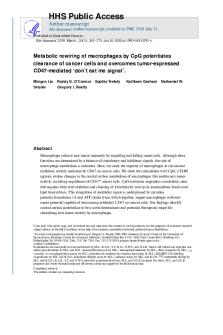Ch10Motivation CP - CP10 Emotion PDF

| Title | Ch10Motivation CP - CP10 Emotion |
|---|---|
| Author | Anonymous User |
| Course | Cognitive Psychology |
| Institution | University of Colorado Boulder |
| Pages | 2 |
| File Size | 67.1 KB |
| File Type | |
| Total Downloads | 64 |
| Total Views | 147 |
Summary
CP10 Emotion...
Description
Chapter 10: Motivation Class Preparation 28 Points
Chapter 10 pp. 331 - 351: Motivation 1. Define motivation. (1 point) Motivation describes the wants or needs that direct behavior toward a goal. 2. Distinguish intrinsic and extrinsic motivation. Provide a specific personal example of each. (4 points) ! Intrinsic motivation is arriving from internal factors and extrinsic arising from external factors. Intrinsically motivated behaviors are performed because of the sense of personal satisfaction that they bring. More of a mental reward, while extrinsically motivated behaviors are performed in order to receive something from others. Physical reward" 3. Define Homeostasis. Describe how drive-reduction theory works based on homeostasis (do NOT do so using an example; describe it in more general theoretical terms). (5 points) Homeostasis is the tendency to maintain balance, or optimal level, within a biological system. Drive-reduction theory works based on homeostasis motivation, deviations from homeostasis create physiological needs. These needs result in psychological drive states that direct behavior to reduce the drive, meet the need and, ultimately, bring the system back to homeostasis. 4. Describe arousal theory and provide a specific personal example? (3 points) Arousal theory is an optimal level of arousal that we try to maintain in theories. ! ! ! When we are under aroused we become bored on the other hand if we are over !! ! aroused we will engage in behaviors to reduce our arousal. One of the ! ! ! ! assertions of the arousal theory of motivation is that our levels of arousal can ! ! ! influence our performance. 5. List off the levels in Maslow's hierarchy of needs found in Figure 10.5. What is the rule that must be met before one can address higher level needs? (6 points) Maslow's hierarchy of needs are self-actualization, esteem, social, security, ! ! ! psychological. One must satisfy his lower needs before addressing higher level ! ! ! needs. 6. What is self actualization? (1 point) ! Self actualization is a need that essentially equates to achieving one's full ! ! ! potential, and it can only be realized when needs lower on the pyramid have ! ! ! been met." SKIP Section 10.2 Hunger and Eating 7. What is the relationship between women's and men's sexual desire and hormone levels? (1 point) The relationship between women's and men's sexual desire and hormones ! ! ! levels are both men and women varies as a function of circulating testosterone ! ! ! level. 8. What were three of Kinsey’s results regarding sexual behavior? (3 points) Three of Kinsey's results regarding sexual behavior is that the range of sexual ! ! ! behaviors are more common and innocuous.
9. Define sexual orientation. Which side of the nature-nurture issues does sexual attraction/orientation (i.e., sexual motivation) seem to support more? Provide one piece of research supporting that side. (4 points) Sexual orientation is an individuals emotional and erotic attractions to same’ sex, opposite sex, or both. I believe that sexual orientation is more on the nurture side than nature....
Similar Free PDFs

Ch10Motivation CP - CP10 Emotion
- 2 Pages

Cp G
- 30 Pages

Edital CP-CAP 2021 - CP cap 2021
- 81 Pages

Zusammenfassung Allgemeine I - Emotion
- 100 Pages

Emotion in Sports
- 2 Pages

Motivation and Emotion 1
- 58 Pages

MCQChapter 12-Emotion
- 61 Pages

10. neuroscience + emotion
- 4 Pages

Motivation and Emotion 2
- 41 Pages

Motivation and emotion
- 52 Pages

Emotion und Motivation
- 135 Pages

Emotion performance - article
- 1 Pages

Social Psychology of Emotion
- 22 Pages

Solución CP Talleres Torreta
- 1 Pages

Resumo CP Prova 1
- 20 Pages
Popular Institutions
- Tinajero National High School - Annex
- Politeknik Caltex Riau
- Yokohama City University
- SGT University
- University of Al-Qadisiyah
- Divine Word College of Vigan
- Techniek College Rotterdam
- Universidade de Santiago
- Universiti Teknologi MARA Cawangan Johor Kampus Pasir Gudang
- Poltekkes Kemenkes Yogyakarta
- Baguio City National High School
- Colegio san marcos
- preparatoria uno
- Centro de Bachillerato Tecnológico Industrial y de Servicios No. 107
- Dalian Maritime University
- Quang Trung Secondary School
- Colegio Tecnológico en Informática
- Corporación Regional de Educación Superior
- Grupo CEDVA
- Dar Al Uloom University
- Centro de Estudios Preuniversitarios de la Universidad Nacional de Ingeniería
- 上智大学
- Aakash International School, Nuna Majara
- San Felipe Neri Catholic School
- Kang Chiao International School - New Taipei City
- Misamis Occidental National High School
- Institución Educativa Escuela Normal Juan Ladrilleros
- Kolehiyo ng Pantukan
- Batanes State College
- Instituto Continental
- Sekolah Menengah Kejuruan Kesehatan Kaltara (Tarakan)
- Colegio de La Inmaculada Concepcion - Cebu
